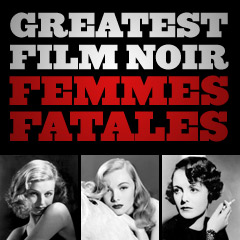
|
Femmes Fatales in Classic Film Noir Introduction |
Femme fatale literally means "killer (or deadly) woman." See Pictorial Guide to the 50+ Greatest Femmes Fatales (Classic Film Noir) The character type of femme fatale was derived from the anti-heroine vamps of early cinema, such as Theda Bara in A Fool There Was (1915). She was first introduced as an evil temptress with her character name of Vampire, and she spoke her most-famous line of all: "Kiss me, my Fool!" The full-bosomed Bara, dubbed the "Vamp," was the screen's first femme fatale, predatory vamp and first movie sex goddess. She was a Hollywood creation who mixed ruthlessness and dark erotic sexiness into her numerous roles. Flappers in the Roaring Twenties, helped along with the popularity of "It" Girl Clara Bow, and the German film Pandora's Box (1929) with Louise Brooks as the iconographic and erotic femme fatale, also contributed to the archetypal development of the character. The females in film noir were either of two types (or archetypes) - dutiful, reliable, trustworthy and loving women; or femmes fatales - mysterious, duplicitous, subversive, double-crossing, gorgeous, unloving, predatory, tough-sweet, unreliable, irresponsible, manipulative and desperate women. Usually, the male protagonist in film noir wished to elude his mysterious past, and had to choose what path to take (or have the fateful choice made for him). Invariably, the choice would be an overly ambitious one, to follow the dangerous but desirable wishes of these sexually-attractive, cunning dames (or "spider women"). The goadings of the traitorous, self-destructive femme fatale would lead the struggling, disillusioned, and doomed hero into committing murder or some other crime of passion coupled with twisted love, in order to gain wealth or power. When the major character was a detective or private eye, he would become embroiled and trapped in an increasingly-complex, convoluted case that would lead to fatalistic, suffocating evidences of corruption, irresistible love and death. The femme fatale, who had also transgressed societal norms with her independent and smart, menacing actions, would bring both of them to a downfall. For film historians, the rise of the femme fatale character in the war years signified male fears of women who had become liberated on the homefront during the war. The character of the 'femme fatale' gave actresses some of the best and most compelling roles they would ever have - outside of their more customary roles in womens' films, melodramas, straight dramas and romantic comedies. Some of the greatest female actresses of all time starred in film noirs, such as Barbara Stanwyck, Rita Hayworth, Veronica Lake, Joan Bennett, Lana Turner, Mary Astor, Ava Gardner, Joan Crawford, Gene Tierney, and Bette Davis. There were also many mostly unknown actresses who rose to prominence through film noir, such as Jane Greer, Gloria Grahame, Linda Darnell, Lizabeth Scott, Peggy Cummins and others. However, a few of the greatest film noirs ever made
didn't have a specific or major evil femme fatale role - but
some did have a notable female character, such as in: Kiss of
Death (1947), Cry of the City (1948), The Naked City
(1948), Raw Deal (1948), They Live By Night (1949), There was a resurgence of the neo-noir femme fatale (screen temptress) character in the 60s-70s, such as Anne Bancroft in The Graduate (1967), and Faye Dunaway's character in Chinatown (1974), and also in the liberated 1980-1990s and beyond, i.e. Kathleen Turner in Body Heat (1981), Sharon Stone in Basic Instinct (1992), Linda Fiorentino in The Last Seduction (1994), Nicole Kidman in To Die For (1995), Laura Harring in Mulholland Dr. (2001), and Rebecca Romijn in Femme Fatale (2002). Note: The
films that are marked with a yellow star Key to Icon Symbol: |
(chronological by film title) Introduction | Picture Guide | 1941 | 1944 | 1945 | 1946-1 | 1946-2 | 1947-1 | 1947-2 1948 | 1949 | 1950-1952 | 1953 | 1954-1956 | 1957-1959 |